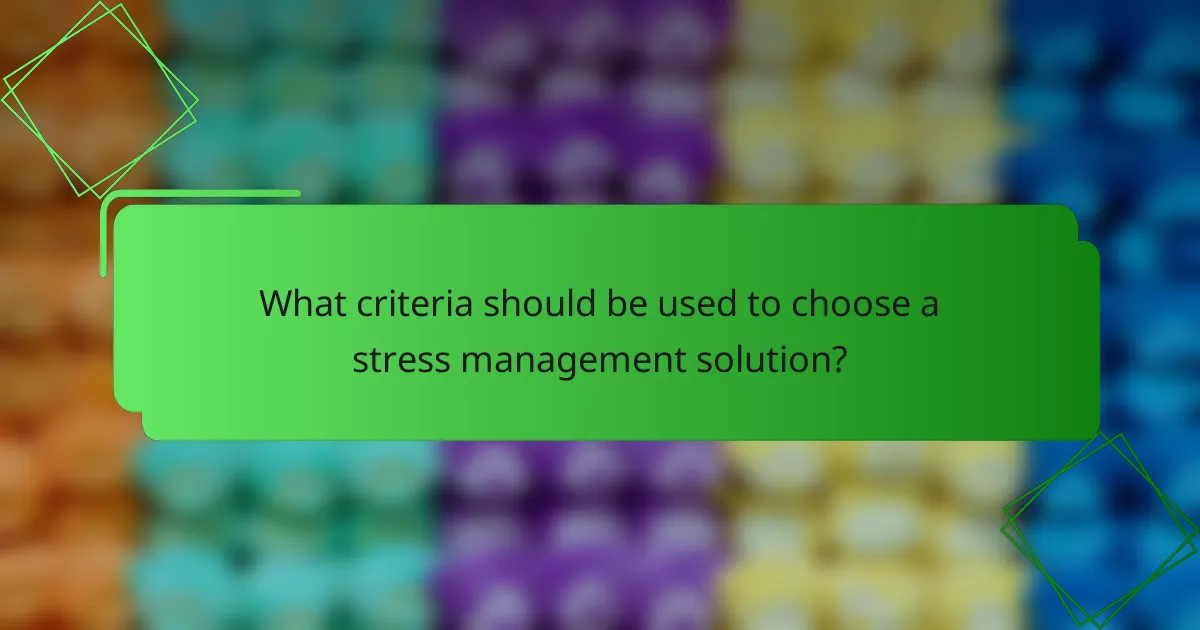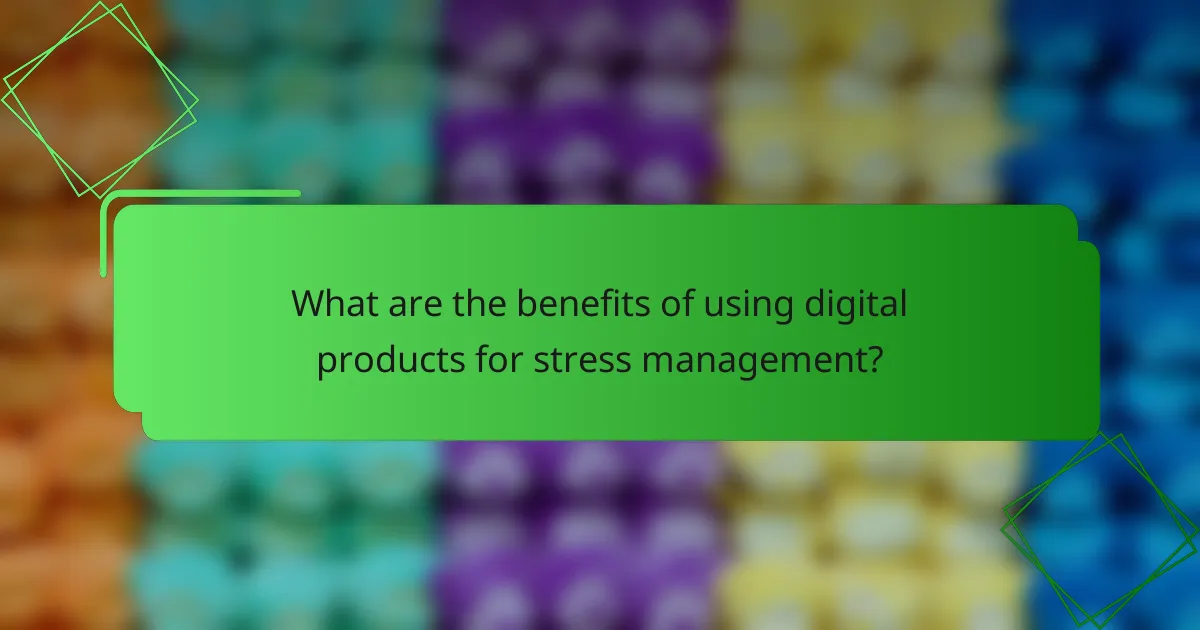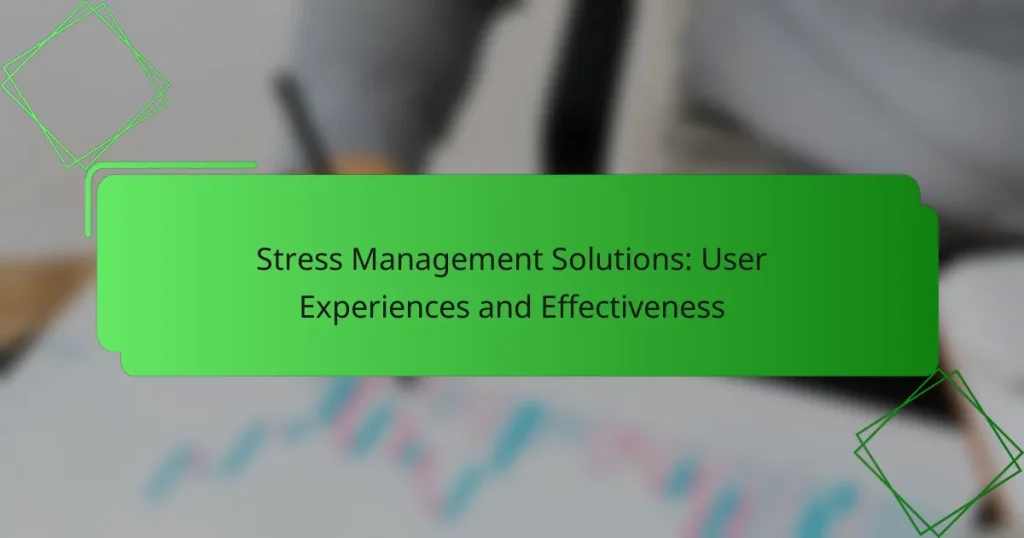Stress management solutions encompass a variety of tools and techniques aimed at helping individuals navigate stress and enhance their well-being. From digital applications to online therapy and biofeedback devices, each option offers distinct advantages tailored to different preferences. User experiences can vary widely, influenced by factors such as ease of use and perceived effectiveness, making it essential to evaluate accessibility and personal relevance when selecting the right solution.

What are effective stress management solutions?
Effective stress management solutions include various tools and techniques designed to help individuals cope with stress and improve their overall well-being. These solutions range from digital applications and online therapy to courses and biofeedback devices, each offering unique benefits and approaches.
Meditation apps like Headspace
Meditation apps such as Headspace provide guided sessions that help users practice mindfulness and relaxation techniques. These apps typically offer a variety of programs tailored to different needs, such as stress relief, sleep improvement, and focus enhancement.
Users can choose from short sessions of just a few minutes to longer practices, making it easy to fit meditation into a busy schedule. Regular use can lead to improved emotional regulation and decreased anxiety levels.
Online therapy platforms such as BetterHelp
Online therapy platforms like BetterHelp connect users with licensed therapists through video, phone, or chat sessions. This flexibility allows individuals to seek support from the comfort of their homes, making therapy more accessible.
These platforms often offer subscription plans, which can be more affordable than traditional in-person therapy. Users should consider their specific needs and preferences when choosing a therapist to ensure a good fit.
Stress relief courses on Udemy
Stress relief courses on platforms like Udemy provide structured learning experiences focused on various stress management techniques. These courses can cover topics such as mindfulness, time management, and cognitive behavioral strategies.
Typically priced affordably, these courses allow users to learn at their own pace. It’s important to read reviews and check course content to find one that aligns with personal goals and learning styles.
Biofeedback devices like Muse
Biofeedback devices such as Muse use sensors to monitor physiological responses like heart rate and brain activity, providing real-time feedback to users. This technology helps individuals learn to control their stress responses through guided exercises and meditation.
While these devices can be effective for some, they may require an initial investment and a learning curve to fully benefit from their features. Users should consider their comfort with technology and their specific stress management goals when choosing a device.

How do user experiences vary across different solutions?
User experiences with stress management solutions can differ significantly based on individual preferences and specific techniques used. Factors such as ease of use, perceived effectiveness, and personal relevance play crucial roles in shaping these experiences.
User reviews of Calm app
The Calm app generally receives positive feedback for its user-friendly interface and diverse range of features, including meditation sessions, sleep stories, and breathing exercises. Users often appreciate the app’s ability to help reduce anxiety and improve sleep quality.
However, some reviews highlight that the subscription cost may be a barrier for potential users, as many features are locked behind a paywall. Additionally, while some users find the content highly effective, others may feel that the app lacks depth in certain areas, such as personalized guidance.
Effectiveness of guided imagery techniques
Guided imagery techniques are often praised for their ability to promote relaxation and reduce stress by encouraging users to visualize calming scenes or experiences. Many individuals report feeling more centered and less anxious after engaging in these practices.
To maximize effectiveness, it is recommended to practice guided imagery in a quiet environment and to use a structured approach, such as following audio recordings or scripts. However, results can vary; some may find it challenging to concentrate or visualize effectively, which can hinder the benefits.

What criteria should be used to choose a stress management solution?
Choosing a stress management solution involves evaluating its accessibility, cost, and user experience. These criteria help ensure that the selected method effectively meets individual needs and preferences.
Accessibility of digital products
Accessibility is crucial when selecting a stress management solution, especially for digital products. Ensure that the platform is compatible with various devices, such as smartphones, tablets, and computers, allowing for easy access anytime and anywhere.
Consider whether the product offers features like offline access or support for different languages. This can enhance usability for a broader audience, making it easier for individuals to engage with the solution consistently.
Cost considerations for subscriptions
Cost is a significant factor when evaluating stress management solutions, particularly subscription-based services. Prices can vary widely, often ranging from low monthly fees to more substantial annual commitments, so it’s essential to assess your budget before committing.
Look for free trials or tiered pricing options that allow you to test the service before fully investing. Be cautious of hidden fees or automatic renewals that may increase costs unexpectedly.
User interface and experience
The user interface and overall experience of a stress management solution can greatly affect its effectiveness. A clean, intuitive design can make it easier to navigate and engage with the content, leading to better outcomes.
Prioritize solutions that offer a seamless experience, including clear instructions and responsive customer support. Gathering feedback from other users can also provide insights into how well the interface meets their needs and enhances their stress management efforts.

What are the benefits of using digital products for stress management?
Digital products for stress management offer users flexibility, accessibility, and tailored solutions that can enhance their well-being. These tools, such as apps and online platforms, provide resources that are readily available, making it easier to incorporate stress relief practices into daily life.
Convenience of on-demand access
One significant advantage of digital stress management tools is their on-demand access. Users can engage with these resources anytime and anywhere, whether at home, work, or on the go. This flexibility allows individuals to practice stress relief techniques when they need them most, rather than adhering to a fixed schedule.
For example, a user can quickly access a meditation app during a stressful workday or utilize breathing exercises while commuting. This immediacy can help mitigate stress levels in real-time, providing a practical solution to everyday challenges.
Personalization features in apps
Many digital stress management products incorporate personalization features that cater to individual needs and preferences. Users can often customize their experience by selecting specific techniques, setting goals, and tracking progress over time. This tailored approach can enhance engagement and effectiveness.
For instance, an app may allow users to choose between guided meditations, mindfulness exercises, or stress-reduction games based on their personal stress triggers. This level of customization helps ensure that users are more likely to stick with the program and find the methods that work best for them.

What are common challenges users face with stress management solutions?
Users often encounter several challenges when trying to implement stress management solutions, including maintaining consistency and feeling overwhelmed by the variety of available options. These obstacles can hinder the effectiveness of stress relief strategies and lead to frustration.
Difficulty maintaining consistency
One of the primary challenges users face is the difficulty in maintaining consistency with stress management practices. Many individuals start with enthusiasm but struggle to integrate these techniques into their daily routines. This inconsistency can diminish the potential benefits of practices like meditation, exercise, or journaling.
To improve consistency, users should set realistic goals and create a structured schedule. For example, dedicating just 10-15 minutes each day to mindfulness can be more effective than sporadic longer sessions. Additionally, using reminders or apps can help reinforce these habits.
Overwhelm from too many options
The abundance of stress management solutions can lead to overwhelm, making it challenging for users to choose the right approach. With options ranging from yoga and therapy to digital apps and herbal supplements, individuals may feel paralyzed by decision fatigue.
To navigate this, users should start by identifying their specific stressors and preferences. Creating a shortlist of 2-3 methods to try can simplify the process. For instance, if someone enjoys physical activity, they might focus on yoga or tai chi rather than exploring unrelated options.

How do cultural factors influence stress management approaches?
Cultural factors significantly shape stress management approaches by influencing perceptions of stress, coping mechanisms, and the social support available. Different cultures may prioritize various methods, such as individualistic strategies in Western societies versus collectivist approaches in Eastern cultures.
Individualistic vs. collectivist cultures
In individualistic cultures, such as the United States and many Western European countries, stress management often emphasizes personal responsibility and self-care techniques. Individuals may seek therapy, engage in physical fitness, or practice mindfulness as primary coping strategies.
Conversely, collectivist cultures, like those in many Asian and African nations, may focus on community and family support systems. Stress relief might involve group activities, family gatherings, or seeking guidance from elders, reflecting a shared responsibility for mental well-being.
Religious and spiritual influences
Religious beliefs can play a crucial role in stress management across various cultures. In many societies, practices such as prayer, meditation, or participation in religious rituals provide comfort and a sense of community, helping individuals cope with stress.
For instance, in predominantly Christian cultures, prayer and church attendance may serve as effective stress relief methods. In contrast, in cultures with strong Buddhist influences, mindfulness meditation and the practice of compassion can be central to managing stress.
Socioeconomic factors
Socioeconomic status can also influence stress management approaches. In wealthier nations, access to mental health resources, such as therapy and wellness programs, tends to be higher, allowing for a variety of stress management options.
In lower-income regions, individuals may rely more on informal support networks and community resources. Understanding these socioeconomic factors is essential for tailoring effective stress management strategies that resonate with specific cultural contexts.


